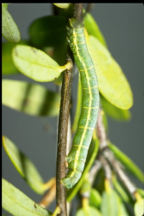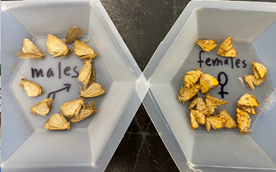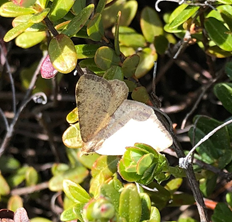Green Cranberry Spanworm in MA Cranberry (March 2023)


Green cranberry spanworm, Macaria sulphurea [syn. Speranza sulphurea] caterpillar (larva) on left, pupa and adult female moth on right.
Over the past few years, we have observed that green cranberry spanworm has shifted to earlier seasonal activity, so sweeping and management need to be adjusted. The caterpillar is slender and they are called loopers or inchworms, owing to the way they walk. Note that the larva has only two pairs of legs on posterior end.

Locomotion of a spanworm showing the looping walk. Image: T. Yoshioka
Biology
Green cranberry spanworm is a geometer moth in the moth family Geometridae. There is one generation per year. The female moth scatters eggs singly among the trash litter under the vines beginning in June. Each female lays about 125 eggs. The egg is the overwintering stage. Egg hatch the following spring begins in April. H.J. Franklin reported that hatch occurs over an extended period and that the eggs survive flooding, even when held late in spring. Smaller larvae have light-white lines along the back, while fully mature larvae have a narrow yellow stripe along each side. When disturbed, green spanworm larvae avoid predators by remaining motionless to resemble the background.

A heap of lab- held pupae and pre-pupae. Larvae completed development by the end of May, so management should not be delayed into June.
Individuals held in the lab completed development and formed pupae (the metamorphosing stage) by the end of May. The pupal stage lasts 10 days. Moths flew by June 8.

Male moths are lighter colored (left) than the more sulfur-yellow females (right). They fly in early June.
Male moths are pale tannish and have a wingspan of about an inch. They begin emerging earlier than females, and are active on the bog during the day. Female moths are sulphur-yellow and are about 7/8” across with noticeable brown spots. Over time, the moths lose the scale cover on the wings, so older moths may be paler and females may have less clear markings.
Injury
The larva feeds on leaves and developing buds and may nip off flower buds. There is no webbing associated with the larvae.

A fully developed green spanworm caterpillar is shown feeding on the blossom buds. Note that they never get very large and stop feeding when they are still slender and only about one inch long.
Management
Sanding buries the overwintering eggs, and H.J. Franklin reported that this reduces the population since larvae fail to emerge. Spring sweeping is critical for effective management. We have observed earlier activity for this species than historically reported. Expect green spanworm in early season sweeps, starting in May. The long-time threshold for small larvae is an average of 18 per sweep set, and this threshold may be lowered a bit if the larvae are full grown. Avaunt, Delegate, and Intrepid are effective insecticide choices. Intrepid is an excellent choice as it conserves natural enemies, such as the critical ones that parasitize Sparganothis fruitworm. To be most effective, Intrepid’s target is small larvae.

Combined sweep net collections showing variation in larval spanworm size. Abundant and tiny yellow Collembola (Springtails) are also seen in this collection.
Moth flight begins on the bog in the second and third week of June. The adult moths are flushed up and out of the vines and engage in short, jumpy flights just above the vine canopy. Male moths are more active than females, but often rest among the vines. They could be confused with brown spanworm moths, which are brown.

Light-colored males of the green spanworm are often seen flying in mid-June. They may appear more butterfly-like than moth-like.